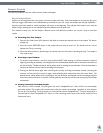
Torq User Guide » Chapter 1
29
Torq User Guide » Chapter 6
29
< Erratic Playback Position
If Torq seems to be jumping around to random locations in the song during playback, take a look at the Position
display. This number should be rapidly growing larger as the control source plays. If this number looks like it’s
counting erratically, this is most likely due to damaged control records (which is normal after extended use). This
could also be due to poor stereo separation in the turntable’s needle or preamp. This is especially common with
very old needles. To x this, purchase a replacement vinyl record, replace your stylus, or purchase one of the
recommended styli/cartridges listed at the end of this manual.
< Erratic Velocity Values
A turntable is a very sensitive piece of equipment. It can take the smallest vibrations and amplify them into audible
sound. That’s what’s happening when you play a record—the grooves in the record vibrate the stylus as they play
and those vibrations are translated to audio. The problem with turntables, though, is that they cannot distinguish
between what is an intentional vibration caused by the moving grooves in the record and an unintentional vibration
picked up through the body of the turntable. For example, if you kick the table the turntable is on, that “thump”
will be transferred through the turntable up through the needle and translated into sound.
What this means, in terms of the External Control system, is that vibrations and other unintentional noise can
“contaminate” the control signals being read from the records. When this happens, the noise can temporarily
throw off the ability of Torq to track the records.
In order to help minimize this problem, Torq has a setting called “Power Threshold” with various level settings.
The idea is to set this value above any of the extraneous noise such that Torq will only focus on the louder control
signals from the records. Here’s how to set this level properly:
1. Open the External Control Preferences and enable External Control.
2. Place the needle of your turntable on the Control Vinyl, but leave the turntable stopped.
3. Lower the Power Threshold to -40 and look at the Velocity value for the deck.
4. If the Velocity is showing random values even though the turntable is stopped, that means the Power
Threshold is too low—Torq is picking up noise and interpreting it as a control signal.
5. Increase the Power Threshold by 5dB and look at the Velocity value again. If you still see random Velocity
values, raise the Power Threshold another 5dB.
6. Eventually, you’ll reach a point where the Velocity stays at 0.00. This is the optimal setting for the Power
Threshold.
7. Please note that, if you’re in a noisy environment that does not have good physical isolation of the turntables
(to prevent external vibrations from being picked up by the stylus), you may need to raise the Power
Threshold setting a little higher to lter out the additional noise in the room.
Error Index
If you’ve checked your audio cable connections and have also replaced your turntable’s needles yet still experience problems,
take a look at the Error Index displays. These displays will be showing a number typically between 0.15 and 1.50, which is
perfectly normal. If the number is above 2.0, it will turn red, indicating that there is too much noise in the audio signal for
Torq to properly track position and velocity. Try cleaning the record using a high quality vinyl cleaning system. Too much
dirt on the record can cause errors in the tracking process.
A high Error Index can also be caused by wear and tear on the Control Vinyl. Each time a record is played, it is slightly
damaged, especially if the tracking weight of the needle is very heavy. After repeated use, the control signal may become
distorted and unreadable. Simply ip over the Control Vinyl to the second side or purchase a replacement record from the
M-Audio Webstore (www.m-audio.com).
If the output level of your stylus/cartridge is too low, this can also result in high Error Index readings. Try replacing your
stylus/cartridge with one of the recommended models at the end of this manual for a higher output level.


















